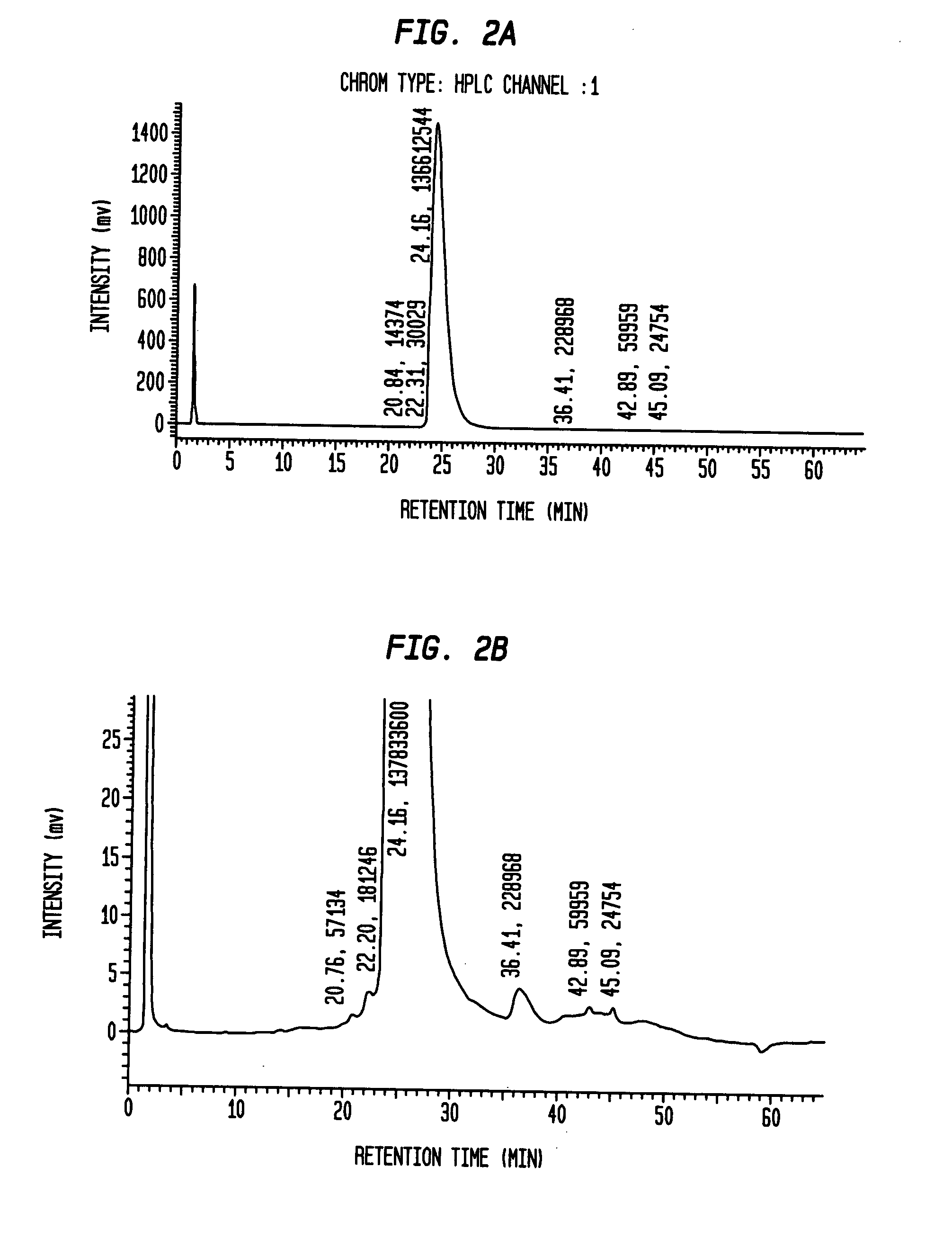Insulin production methods and pro-insulin constructs
a technology of pro-insulin and production methods, which is applied in the field of recombinant proteins and peptides, can solve the problems of low insulin yield, entail the inconvenience of using laborious purification steps, and reduce the yield of refolded pro-insulin having correctly folded disulfide bonds
- Summary
- Abstract
- Description
- Claims
- Application Information
AI Technical Summary
Benefits of technology
Problems solved by technology
Method used
Image
Examples
example 1
General Materials and Methods
[0049]The present example describes some of the general techniques used in the preparation and purification of the human pro-insulin product and in the further processing of the pro-insulin into a human insulin product.
[0050]A general outline of one method, by way of example and not exclusion, to isolate and / or enrich recombinant insulin from a composition that is not enriched for recombinant insulin and / or includes pro-insulin can be described by the following series of steps:[0051]1. Fermentation of E. coli transformed with the vector containing the human pro-insulin derivative-encoding amino acid sequence:[0052]2. Lysis—Lyse the E. coli cells containing inclusion bodies enriched with the desired peptide, resuspended in a basic Tris / salt buffer, using a Niro Soavi homogenizer.[0053]3. Inclusion Body Washing—Contaminant protein removal is then accomplished via two sequential washes with a Tris / Triton X-100 buffer, followed by two sequential washes with ...
example 2
Process for Preparation of Human Pro-insulin Derivative in a Modified ptrcHis 2A (Kan) Vector
[0063]The present example demonstrates one of the expression vectors that may be used in the preparation of an appropriate vector that may be used to transform an appropriate cell capable of expressing the human pro-insulin derivative. The specific vector described here is the ptrcHis2A vector. This ptrcHis2A vector was first modified before the human pro-insulin derivative-encoding nucleic acid sequence was inserted into the vector.
[0064]The ptrcHis2A vector may be purchased from a commercial vendor (e.g., Invitrogen). Such a vector will then be modified to include a Kanamycin resistance gene in the middle of the ampicillin resistance gene so as to negate the ampicillin resistance. Ampicillin resistance heightens the potential for allergic reactions to preparations made using vector constructs that include the ampicillin resistance gene. Therefore it is preferable to eliminate the ampicilli...
example 3
Construction of Purified Human ProInsulin Gene Segment for Insertion into Vector
[0065]The present example is presented to demonstrate an example of the steps of a process that may be used in the present invention for preparing the human pro-insulin derivative nucleic acid sequence, as well as for preparing the modified C-peptide construct disclosed herein. The nucleic acid segment isolated in the present example was used as the starting material for creating the various insertion nucleic acid sequences described in the following examples.
[0066]The nucleic acid sequence of ATCC deposited clone, MCG-12292, was identified by the present inventors to include a nucleic acid sequence that encoded the native human pro-insulin gene. The human pro-insulin gene sequence was isolated from the nucleic acid sequence of the ATCC deposited clone, MCG-12292, and employed as a starting material in the preparation of the various modified forms of human pro-insulin and pro-insulin derivatives having t...
PUM
| Property | Measurement | Unit |
|---|---|---|
| Fraction | aaaaa | aaaaa |
| Time | aaaaa | aaaaa |
| Composition | aaaaa | aaaaa |
Abstract
Description
Claims
Application Information
 Login to View More
Login to View More - R&D
- Intellectual Property
- Life Sciences
- Materials
- Tech Scout
- Unparalleled Data Quality
- Higher Quality Content
- 60% Fewer Hallucinations
Browse by: Latest US Patents, China's latest patents, Technical Efficacy Thesaurus, Application Domain, Technology Topic, Popular Technical Reports.
© 2025 PatSnap. All rights reserved.Legal|Privacy policy|Modern Slavery Act Transparency Statement|Sitemap|About US| Contact US: help@patsnap.com



